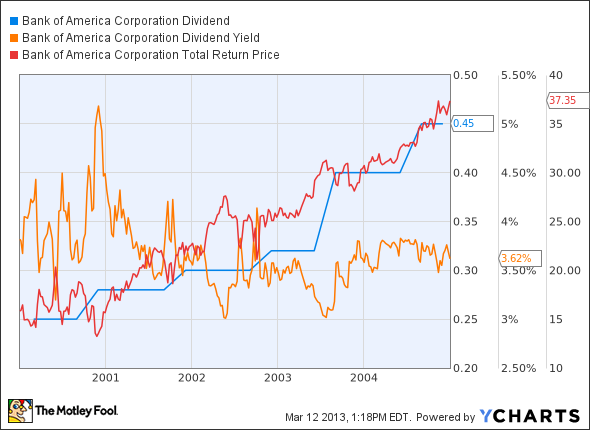How Dividends Could Change the Game for Bank of America
The wealth-building power of compound interest will never cease to amaze me. It's a story of patience and attention to detail, where small differences in the short term add up to massive divergence over decades. In the end, the biggest winners don't always deliver the fattest share-price returns.
Bank of America slashed its dividend by 98% when the housing bubble popped in 2008. Regulatory oversight and financial stress tests have kept the annual payouts down at just $0.04 per share for a minuscule 0.3% dividend yield. At these rates, it will take a long time for Bank of America shares to build any real wealth for income investors.
But recent rumblings indicate that the Fed might let this megabank raise dividends again. Fellow money-center bank Wells Fargo was able to inch payouts up as soon as 2011 and has quadrupled its dividend rates over the last three years. JPMorgan Chase multiplied its payout fivefold in 2011 and has stayed strong ever since. These increases prove that the largest banks aren't necessarily too big to succeed.
Their dividend moves actually have a direct effect on Bank of America. The last time Wells Fargo boosted its payout, the news sent B of A shares up nearly 2% on an otherwise slow news day. Investors do take rival bank moves as an indication of things to come for this giant.
What if?
Both Wells and JPMorgan have just about restored their payouts to pre-crisis levels. What if Bank of America were allowed to do the same? Here's how the bank's dividends helped investors beat the market in a different era:
Yes, Bank of America crushed the Dow Jones Industrial Average in the early aughts, with or without dividends. The real-estate bubble was just blowing up and getting ready to pop.
Focus your attention on the gap between straight-up share price gains and total, dividend-adjusted returns. Those steady payments added up to a 42% stronger total return on your investment. Not bad for just five years of market action.
Where did that spread come from?
It's the same old story you've heard a million times before. Bank of America's long-term shareholder value rested on a generous and always growing dividend policy
Crucially, the bank hiked its per-share payouts roughly in time with its rising share prices. That way, yields stayed steady around the 3% mark for several years. Management has said it would like to pay out roughly 30% of earnings in dividend form. That would add up to about $0.08 per share at current run rates, or $0.30 per share against estimated earnings for 2013. At that pace, Bank of America could be back to a 2.5% yield by the end of the year.
BAC Dividend data by YCharts.
You never really know what the Fed might do, but you can bet that a payout hike like that would boost the already strong stock even further. You'll note that JPMorgan and Wells Fargo now trade above their prices from early 2008, while Bank of America has lost 67% of its value. Citigroup , which cut dividends even more and seems further from returning to its old ways, is down by 80%. Big banks live and die by their dividends.
Bank investors everywhere are keeping their fingers crossed for the Fed's final nod of approval here.
The Motley Fool's chief investment officer has selected his No. 1 stock for the next year. Find out which stock it is in the brand-new free report: "The Motley Fool's Top Stock for 2013." Just click here to access the report and find out the name of this under-the-radar company.
The article How Dividends Could Change the Game for Bank of America originally appeared on Fool.com.
Fool contributor Anders Bylund holds no position in any company mentioned. Check out Anders' bio and holdings or follow him on Twitter and Google+. The Motley Fool owns shares of Bank of America, Citigroup, JP Morgan Chase, and Wells Fargo. Motley Fool newsletter services have recommended buying shares of Wells Fargo. The Motley Fool has a disclosure policy. We Fools may not all hold the same opinions, but we all believe that considering a diverse range of insights makes us better investors. Try any of our Foolish newsletter services free for 30 days.
Copyright © 1995 - 2013 The Motley Fool, LLC. All rights reserved. The Motley Fool has a disclosure policy.



